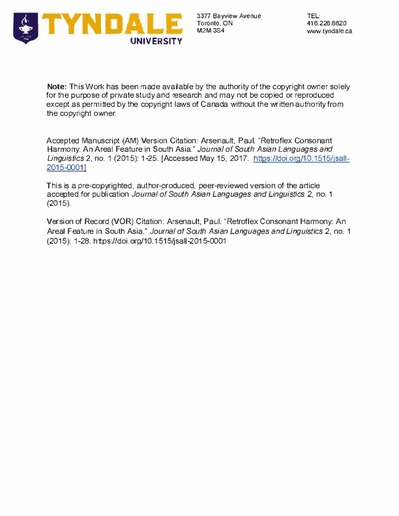| dc.rights.license | Attribution-NonCommercial-NoDerivatives 4.0 International License | en_US |
| dc.contributor.author | Arsenault, Paul | |
| dc.date.accessioned | 2021-09-23T20:41:42Z | |
| dc.date.available | 2021-09-23T20:41:42Z | |
| dc.date.copyright | 2015 | |
| dc.date.issued | 2015 | |
| dc.identifier.citation | Accepted Manuscript (AM) Version Citation: Arsenault, Paul. “Retroflex Consonant Harmony: An Areal Feature in South Asia.” Journal of South Asian Languages and Linguistics 2, no. 1 (2015): 1-25. [Accessed May 15, 2017. https://doi.org/10.1515/jsall-2015-0001] | en_US |
| dc.identifier.issn | 2196-078X | en_US |
| dc.identifier.uri | https://digitalcollections.tyndale.ca/handle/20.500.12730/1007 | |
| dc.description.abstract | Retroflexion is a well-known areal feature of South Asia. Most South Asian languages, regardless of their genetic affiliation, contrast retroflex consonants with their non-retroflex dental counterparts. However, South Asian languages differ in the phonotactic restrictions that they place on retroflex consonants. This paper presents evidence that a large number of South Asian languages have developed a co-occurrence restriction on coronal obstruents that can be described as retroflex consonant harmony. In these languages, roots containing two non-adjacent coronal stops are primarily limited to those with two dentals (T...T) or two retroflexes (T...T), while those containing a combination of dental and retroflex stops are avoided (*T...T, *T...T). Historical-comparative evidence indicates that long-distance retroflex assimilation has contributed to the development of this phonotactic pattern (T...T → T...T). In addition, the paper demonstrates that the distribution of languages with and without retroflex consonant harmony is geographic in nature, not genetic. Retroflex consonant harmony is characteristic of most languages in the northern half of the South Asian subcontinent, regardless of whether they are Indo-Aryan, Dravidian or Munda (but not Tibeto-Burman). It is not characteristic of IndoAryan and Dravidian languages in the south. Thus, retroflex consonant harmony constitutes an areal feature within South Asia. | en_US |
| dc.format.mimetype | application/pdf/ua | en_US |
| dc.language.iso | en | en_US |
| dc.publisher | De Gruyter Mouton | en_US |
| dc.rights | Copyright, De Gruyter Mouton. All rights reserved. | en_US |
| dc.rights.uri | https://creativecommons.org/licenses/by-nc-nd/4.0/ | en_US |
| dc.subject.lcsh | Linguistic analysis (Linguistics) | en_US |
| dc.subject.lcsh | Consonants | en_US |
| dc.subject.lcsh | Assimilation (Phonetics) | en_US |
| dc.subject.lcsh | Areal linguistics | en_US |
| dc.title | Retroflex Consonant Harmony: An Areal Feature in South Asia | en_US |
| dc.type | Article | en_US |
| dc.contributor.affiliation | Tyndale University | en_US |
| dc.contributor.department | Department of Linguistics | en_US |
| dc.contributor.repository | Tyndale University, J. William Horsey Library, 3377 Bayview Ave., Toronto, ON, M2M 3S4, Canada. Contact: repository@tyndale.ca | en_US |
| dc.identifier.issue | no. 1 | en_US |
| dc.identifier.journal | Journal of South Asian Languages and Linguistics | en_US |
| dc.identifier.volume | 2 | en_US |
| dc.publisher.place | Berlin, Germany | en_US |
| dc.relation.isversion of | Version of Record (VOR) Citation: Arsenault, Paul. “Retroflex Consonant Harmony: An Areal Feature in South Asia.” Journal of South Asian Languages and Linguistics 2, no. 1 (2015): 1-28. https://doi.org/10.1515/jsall-2015-0001 | en_US |
| dc.rights.holder | De Gruyter Mouton Genthiner Straße 13 10785 Berlin / Germany Tel: +49 30 260 05-0 Fax: +49 30 260 05-251 E-Mail: service@degruyter.com | en_US |
| dc.subject.keyword | Retroflex | en_US |
| dc.subject.keyword | Consonant harmony | en_US |
| dc.subject.keyword | Phonotactics | en_US |
| dc.subject.keyword | Assimilation | en_US |
| dc.subject.keyword | Areal feature | en_US |
| dc.description.chapterpage | 1-25 | en_US |
| dc.description.note | This is a pre-publication draft. | en_US |
| dc.description.note | For AODA accommodation, including help with reading this content, please contact repository@tyndale.ca | en_US |
| dc.description.version | Pre-publication version | en_US |


